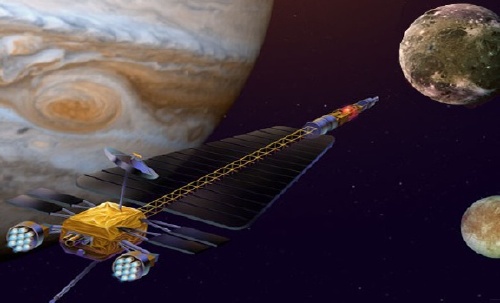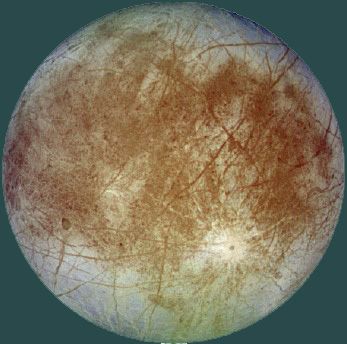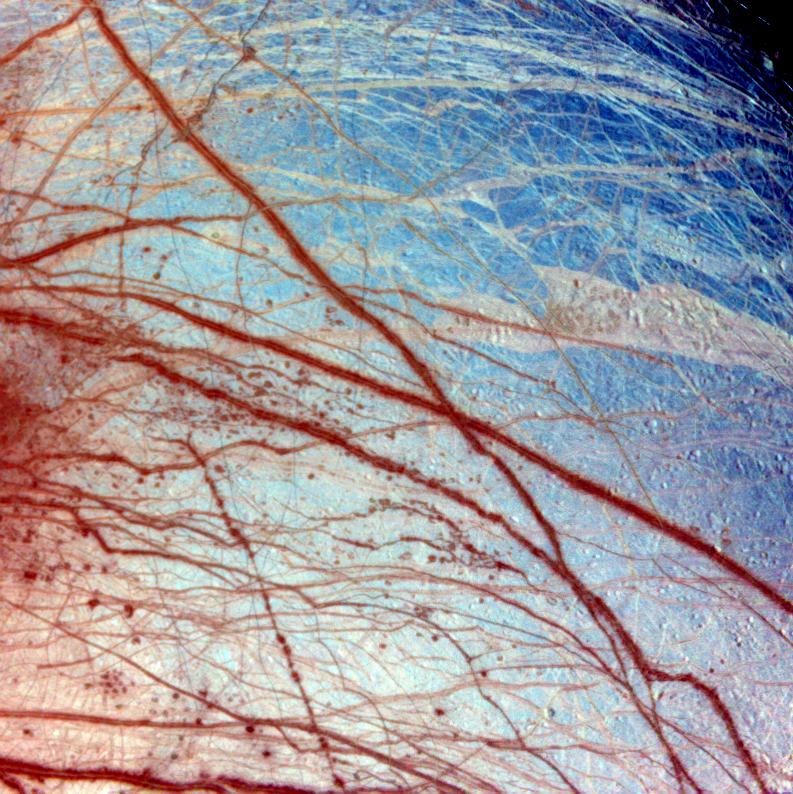 |
|||||
|---|---|---|---|---|---|
| EXPLORING THE JUPITER SYSTEM | |||||
| Jupiter | Moons | Oceans | Volcanos | Rings | Radio |
| JIMO | Galileo | Cassini | Pioneer | Voyager | Resources |
The Jupiter Icy Moons Orbiter:
The Smooth and Bright Moon Europa
Sunlight reflecting off its young icy crust makes Europa's surface among the brightest of any moon in the Solar System.
Jupiter's moon Europa
The big moon's face is among the smoothest of any, without the heavy cratering we see on Callisto and Ganymede. However, it does display lines and cracks that look as if someone had scribbled on it.
Europa's diameter is 1,945 miles. That's bigger than the planet Pluto and two-thirds the size of the planet Mercury. MOON DIAMETERS
Europa may have active innards and its crust may have or had liquid water which can harbor life.
Finding Europa. Galileo Galilei discovered four natural satellites of Jupiter in 1610 – Io, Callisto, Ganymede, Europa. But only recently have we begun to learn more about the moon Europa. A few decades ago, astronomer Gerard Kuiper and others showed that Europa's crust was composed of water and ice.
Then, in the 1970s, the Pioneer and Voyager spacecraft fly-bys of Jupiter and its moons verified Kuiper's analysis of Europa. In the 1990s, the Galileo spacecraft sent back pictures and measurements of the Jupiter system.
Lake Vostok
Lake Vostok is a huge lake of liquid water some 2.5 miles under the solid ice on the surface of Earth's Antarctica. It is 155 miles wide. 25 miles wide, and a quarter mile deep. Even so, the lake water is warm enough to remain liquid.
How does water remain liquid under 2.5 miles of ice in the coldest place on Earth?Ice samples from cores drilled close to the top of the lake are 420,000 years olf. That suggests the lake has been sealed under the icecap from 500,000 to more than a million years.
- Could geothermal heat from radioactive decay in Earth's interior keep it from freezing? Such heat might radiate upward, warming lake bottom rocks.
- Could the ice sheet above act as a blanket, protecting the lake from cold surface temperatures?
- Could it be the lake has not had time to freeze after a mild period ended 5,000 years ago?
- Could the lake remain liquid under the pressure of the ice bearing down on it?
Biologists are excited by the idea of ancient life forms in Lake Vostok unaffected by surface conditions.
Launched in 1989, Galileo worked in orbit around Jupiter from 1995 to 2003. It conduct detailed studies of the giant planet, its largest moons, and the Jovian magnetic environment.
Europa will be the third moon explored by the Jupiter Icy Moons Orbiter, after Callisto and Ganymede.
Atmosphere. The Hubble Space Telescope has found a very tenuous oxygen atmosphere on Europa. Of the dozens of moons in the Solar System, only five others are known to have atmospheres – Io, Callisto, Ganymede, Titan and Triton.
Unlike the oxygen in Earth's atmosphere, Europa's oxygen probably has been generated by sunlight and charged particles hitting Europa's icy surface producing water vapor which is subsequently split into hydrogen and oxygen. The hydrogen is light and escapes Europa's gravity, but the oxygen remains on the moon.
Magnetic field. Galileo found a weak magnetic field around Europa. It is similar to Callisto's and only about one-quarter of the strength of Ganymede's magnetic field. Europa's magnetic field varies in strength as it passes through Jupiter's massive magnetic field.
In 1998, Galileo turned up strong evidence for a conducting material beneath Europa's surface. That probably would be a salty ocean.
The dark reddish streaks and features seen on Europa's surface seem to be rich in salts – such as magnesium sulfate orEpsom salt – deposited by evaporating water that had emerged from within. However, the salts are colorless or white, so some other material such as sulfur or iron compounds must explain the red color.
The question is, does life exist in the ocean under the ice? Could it be thriving in an environment like those deep-ocean hydrothermal vents on Earth? Or an environment like Lake Vostok in the Antarctic?
A view of the surface. The 1996 NASA photo, at right, by the Galileo spacecraft shows the surface of Jupiter's icy moon Europa.
Surface of the moon Europa
click to enlarge Galileo image
False colors enhance certain features in this composite of three photos of the Minos Linea region on Europa.The image covers an area about 780 miles across. The resolution is about one to two miles per picture element.
- Brown and red bands, lines and mottled terrain reveal contaminants in the ice.
- The blue icy plains show different levels of reflectivity, or albedo, because of differences in the size of the grains of the ice.
Source: NASA Jet Propulsion Laboratory
Diameters of the Largest Satellites and the Planets miles miles Mercury 3,031 Saturn 74,901 Venus 7,521 Titan 3,200 Earth 7,927 Rhea 949 Moon 2,160 Iapetus 892 Mars 4,222 Dione 696 Jupiter 88,848 Tethys 650 Ganymede 3,274 Uranus 31,765 Callisto 2,986 Titania 981 Io 2,256 Neptune 31,404 Europa 1,945 Triton 1,678 Pluto 1,440 Charon 790
Learn more about Jupiter and its moons and rings:
Solar System Search STO STO cover Questions Feedback Suggestions © 2004 Space Today Online

